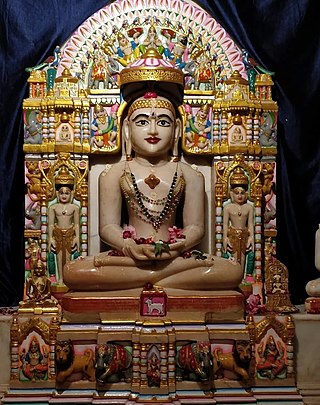Kunthunatha
17th Tirthankara in Jainism in current cycle of Jain cosmology From Wikipedia, the free encyclopedia
Kunthunath was the seventeenth Tirthankara, sixth Chakravartin[3] and twelfth Kamadeva of the present half time cycle, Avasarpini.[1][4] According to Jain beliefs, he became a siddha, liberated soul which has destroyed all of its karma. Kunthunatha was born to King Surya (Sura)[1] and Queen Shridevi at Hastinapur[3] in the Ikshvaku dynasty on the fourteenth day of the Vaishakh Krishna month of the Indian calendar.[4]
| Kunthunatha | |
|---|---|
 The idol of Kunthunatha Bhagwan at a Jinalaya in Raipur, Chhattisgarh | |
| Venerated in | Jainism |
| Predecessor | Shantinatha |
| Successor | Aranatha |
| Symbol | Goat[1] |
| Height | 35 bows (105 metres) |
| Age | over 95,000 years |
| Color | Golden |
| Genealogy | |
| Born | |
| Died | |
| Parents |
|
| Dynasty | Ikshvaku dynasty |
Etymology
Kunthu means heap of Jewels.[3]
Life
According to the Jain belief, he was born in 27,695,000 BC, Like all other Chakravartin, he also conquered all the lands[3] and went to write his name on the foothills of mountains. Seeing the names of other Chakravartin already there, he saw his ambitions dwarfed. He then renounced his throne and became an ascetic for penance.[3] At an age of 95,000 years he liberated his soul and attained Moksha on Mount Shikharji.[3]
Famous Temple
- Prachin Bada Mandir, Hastinapur, Uttar Pradesh
- Ganigitti Jain temple, Hampi
- Kunthunath Temple at Jaisalmer Fort in Jaisalmer, Rajasthan
- Chaubisi of Kunthunatha,Chaubisi of Kunthunatha at National Museum, New Delhi, 15th century
- Prachin Bada Mandir, Hastinapur
- Kunthunath Temple, Madhuban
See also
Wikimedia Commons has media related to Kunthunatha.
References
Sources
External links
Wikiwand - on
Seamless Wikipedia browsing. On steroids.



